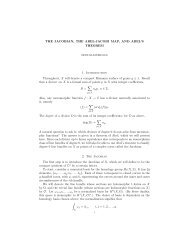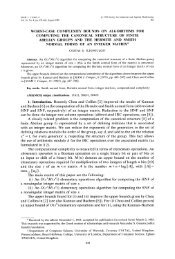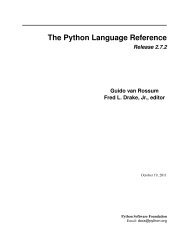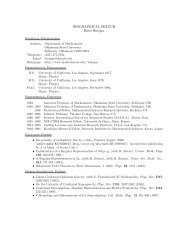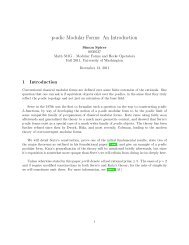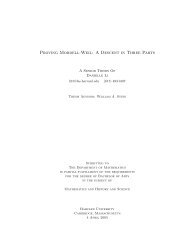Introductory Differential Equations using Sage - William Stein
Introductory Differential Equations using Sage - William Stein
Introductory Differential Equations using Sage - William Stein
Create successful ePaper yourself
Turn your PDF publications into a flip-book with our unique Google optimized e-Paper software.
1.3. EXISTENCE OF SOLUTIONS TO ODES 17<br />
• the function f(x) = x 2 defined on [−3,7] is Lipschitz continuous, with Lipschitz<br />
constant K = 14;<br />
• the function f defined by f(x) = x 3/2 sin(1/x) (x ≠ 0) and f(0) = 0 restricted to<br />
[0,1], gives an example of a function that is differentiable on a compact set while not<br />
being Lipschitz.<br />
Theorem 1.3.2. (“Picard’s existence and uniqueness theorem” [PL-intro]) Suppose f is<br />
bounded, Lipschitz continuous in x, and continuous in t. Then, for some value ǫ > 0,<br />
there exists a unique solution x = x(t) to the initial value problem (1.1) within the range<br />
[a − ǫ,a + ǫ].<br />
Charles Émile Picard (1856-1941) was a leading French mathematician. Picard made his<br />
most important contributions in the fields of analysis, function theory, differential equations,<br />
and analytic geometry. In 1885 Picard was appointed to the mathematics faculty at the<br />
Sorbonne in Paris. Picard was awarded the Poncelet Prize in 1886, the Grand Prix des<br />
Sciences Mathmatiques in 1888, the Grande Croix de la Légion d’Honneur in 1932, the<br />
Mittag-Leffler Gold Medal in 1937, and was made President of the International Congress<br />
of Mathematicians in 1920. He is the author of many books and his collected papers run to<br />
four volumes.<br />
The proofs of Peano’s theorem or Picard’s theorem go well beyond the scope of this course.<br />
However, for the curious, a very brief indication of the main ideas will be given in the sketch<br />
below. For details, see an advanced text on differential equations.<br />
sketch or the idea of the proof: A simple proof of existence of the solution is obtained by<br />
successive approximations. In this context, the method is known as Picard iteration.<br />
Set x 0 (t) = c and<br />
x i (t) = c +<br />
∫ t<br />
a<br />
f(s,x i−1 (s))ds.<br />
It turns out that Lipschitz continuity implies that the mapping T defined by<br />
T(y)(t) = c +<br />
∫ t<br />
a<br />
f(s,y(s))ds,<br />
is a contraction mapping on a certain Banach space. It can then be shown, by <strong>using</strong> the<br />
Banach fixed point theorem, that the sequence of “Picard iterates” x i is convergent and<br />
that the limit is a solution to the problem. The proof of uniqueness uses a result called<br />
Grönwall’s Lemma. □<br />
Example 1.3.2. Consider the IVP<br />
x ′ = 1 − x, x(0) = 1,<br />
with the constant solution x(t) = 1. Computing the Picard iterates by hand is easy:<br />
x 0 (t) = 1, x 1 (t) = 1+ ∫ t<br />
0 1 −x 0(s))ds = 1, x 2 (t) = 1+ ∫ t<br />
0 1 −x 1(s))ds = 1, and so on. Since<br />
each x i (t) = 1, we find the solution







